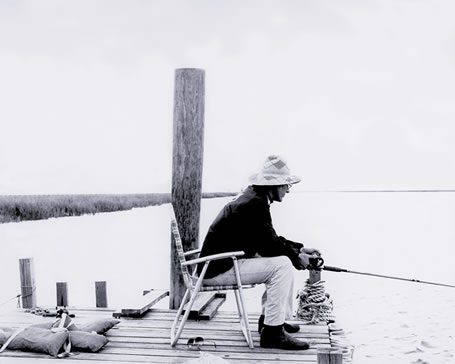

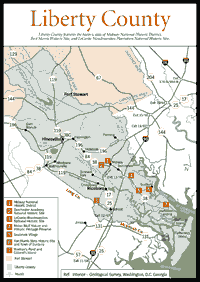 [Fig.
14] Liberty County features the Midway National Historic District, Fort
Morris Historic Site, and LeConte-Woodmanston Plantation National Historic Site.
Also in Liberty County is St. Catherines Island, a magnificent barrier island
owned by a private foundation and closed to the general public. Liberty County
is greatly influenced by the military activities of Fort Stewart, located near
Hinesville. This military base, the largest east of the Mississippi River, controls
one third of the property of the county, with most of the rest in the hands
of pulp and paper companies who manage their acreage for slash pine production.
Hinesville is by far the county's largest town, with a population of 22,000,
and Midway is the next largest town with 900 residents. The total population
of the county is 55,000.
[Fig.
14] Liberty County features the Midway National Historic District, Fort
Morris Historic Site, and LeConte-Woodmanston Plantation National Historic Site.
Also in Liberty County is St. Catherines Island, a magnificent barrier island
owned by a private foundation and closed to the general public. Liberty County
is greatly influenced by the military activities of Fort Stewart, located near
Hinesville. This military base, the largest east of the Mississippi River, controls
one third of the property of the county, with most of the rest in the hands
of pulp and paper companies who manage their acreage for slash pine production.
Hinesville is by far the county's largest town, with a population of 22,000,
and Midway is the next largest town with 900 residents. The total population
of the county is 55,000.
[Fig. 14(1)] Visitors to Midway can tour this pretty, live-oak shaded national historic district, soak up the colonial history of the coast, and learn about the liberty-loving Puritans of St. Johns Parish. Home to the second oldest church in Georgia, many of America's more illustrious citizens have their roots in this charming small town.
In 1630, a group of Puritans from Dorchester, England, fled that country and landed in Massachusetts, where they established a settlement called Dorchester. Years later, some of these colonists moved to South Carolina and established another town called Dorchester. After several years, they became dissatisfied with conditions there, and the entire community of 38 families moved again, this time to St. Johns Parish (Liberty County), and founded yet another town called Dorchester. What the Puritans lacked in imagination they made up in industriousness, and quickly St. Johns Parish became a prosperous community.
The small congregation of Midway Church had a tremendous impact on Georgia and American history and played a major role in representing the Georgia colony when America moved for independence from England. Two of the three Georgia signers of the Declaration of Independence, Dr. Lyman Hall and Button Gwinnett, were from St. Johns Parish. Midway's character was acknowledged in 1777, when the first Georgia Constitution reformed the English parishes of St. Johns, St. Andrews, and St. James into Liberty County, the only original Georgia county not named for a person but an ideal. The small settlement is considered "the cradle of Revolutionary spirit in Georgia" and today is a national historic district.
The settlers first arrived on May 16, 1752. They surveyed the area around Midway, liked what they saw, and petitioned the Council of Georgia for 31,950 acres of land. They were granted their request, and the hard-working Puritans quickly developed successful indigo and rice plantations. The first permanent Meeting House was erected in 1756, and the first service was held January 2, 1758. Midway, also spelled Medway in early documents, is named after the Medway River, believed named for its location "midway" between the Ogeechee and Altamaha rivers or the Medway River in England.
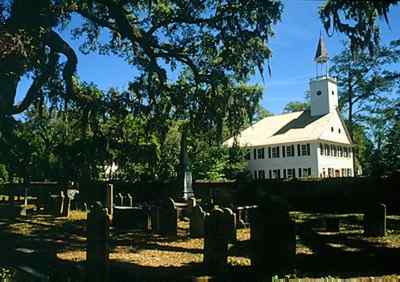 The
first dramatic events of the American Revolution occurred in Massachusetts:
the Boston Tea Party of December 17, 1773, then the closing of Boston Harbor
by the British in June 1774. When independence fever subsequently swept the
colonies, all but Georgia sent representatives to the First Continental Congress
held in Philadelphia in September 1774. Feelings were mixed in the young colony
concerning opposition to English rule. Georgia's royal governor, Sir James Wright,
was a popular and influential leader and many of Georgia's citizens were Tories
or Loyalists with business ties to England and did not want autonomy. Georgia's
lack of participation at the First Continental Congress earned it resentment
from the other colonies, especially South Carolina. The Continental Congress
put Georgia under an embargo. South Carolina, furious with its southern neighbor,
passed a law decreeing death to anyone who traded with Georgia.
The
first dramatic events of the American Revolution occurred in Massachusetts:
the Boston Tea Party of December 17, 1773, then the closing of Boston Harbor
by the British in June 1774. When independence fever subsequently swept the
colonies, all but Georgia sent representatives to the First Continental Congress
held in Philadelphia in September 1774. Feelings were mixed in the young colony
concerning opposition to English rule. Georgia's royal governor, Sir James Wright,
was a popular and influential leader and many of Georgia's citizens were Tories
or Loyalists with business ties to England and did not want autonomy. Georgia's
lack of participation at the First Continental Congress earned it resentment
from the other colonies, especially South Carolina. The Continental Congress
put Georgia under an embargo. South Carolina, furious with its southern neighbor,
passed a law decreeing death to anyone who traded with Georgia.
The citizens of St. Johns Parish still had strong ties to Massachusetts, and were frustrated with Georgia's lack of support for their New England friends. So they decided to act independently of the colony. The colonists, called "those meddlesome Puritans at Midway" by Governor James Wright, decided to curtail trade with the rest of Georgia and asked to be annexed by South Carolina and be represented at the Second Continental Congress. When South Carolina denied its request, the parish sent its own delegate, Dr. Lyman Hall, with 60 barrels of rice and 50 pounds of sterling to help the suffering Boston people. He arrived three days after the Second Continental Congress opened, and sat in on deliberations but did not vote.
Hall was still representing Georgia when the revolution became a shooting war on April 19, 1775 at Lexington, Massachusetts. The start of war enflamed the passions of Georgians who supported independence, prompting Georgia's Second Provincial Congress meeting at Tondee's Tavern, located in Savannah at the corner of Broughton and Whitaker streets. Unlike the First Provincial Congress, when only three parishes bothered to attend, all 12 parishes were represented with more than 100 delegates. Four additional representatives were elected to join Hall in Philadelphia: Archibald Bulloch, John Houstoun, Noble Wymberly Jones, and the Reverand Joachim Zubly. Bulloch was elected governor of Georgia, and was too busy to go to Philadelphia. Houston and Jones went but had to return to Georgia. Zubly was discovered to have Loyalist feelings and was ousted from the group. Button Gwinnett and George Walton took their places, and were present with Hall when the Declaration of Independence was ready to sign. Thus they became immortalized on one of the most important documents in the history of mankind.
Midway's participation in the American Revolution was not limited to politics; the area also witnessed a battle and devastation during British occupation. Toward the end of 1778, the theater of war was transferred to the Southern Provinces. The British planned an invasion of Georgia from Florida. Approximately 700 British forces under Lt. Col. Mark Prevost were to attack Midway by land, then meet up with British naval forces numbering 500 under the command of Lt. Col. L.V. Fuser at Fort Morris and Sunbury on the Medway River (see Fort Morris). From there, they would move on Savannah.
Prevost set out for Midway, destroying plantations in his path, including historic LeConte-Woodmanston Plantation, owned by the famous LeConte family (see LeConte-Woodmanston Plantation National Historic Site). Continental Col. John White posted 100 Continentals with two pieces of light artillery at Midway Church and constructed a breastwork just south of it. General James Screven with 20 mounted militiamen arrived and repositioned the forces 1.5 miles south of the church near Spencer Hill. On November 24, 1778, British forces overwhelmed the outnumbered Americans. Screven was wounded and captured and died of his wounds in the hands of the enemy. (Later, Screven County, the town of Screven in Wayne County, and Fort Screven on Tybee Island were named for him.) White retreated to Midway Church, but in doing so he left behind a fictitious letter intended to deceive the English. The letter said that the Americans were going to be receiving additional troops and making a vigorous stand at Ogeechee Ferry. Prevost, not knowing what to do, burned Midway Church and homes, slave quarters, and crops in the area, then returned to Florida without meeting up with Fuser at Sunbury. (Fuser, unable to meet up with Prevost's land forces, decided to not attack the town or Fort Morris.)
After the war, the Midway Society rebuilt the town. The current church, open to tour, was built in 1792 in a New England style and is the second oldest in Georgia. The area experienced prosperity until the Civil War, when cavalry forces with Union Gen. William T. Sherman invaded the area during his famous March to the Sea. Gen. Judson Kilpatrick occupied Midway and Sunbury for six weeks, destroying plantations, crops, and the railroad. Kilpatrick used the church as a slaughterhouse and the churchyard as a corral. The church's prized melodeon was used as a meat block. (It has been preserved and today is used as a communion table.) Midway was abandoned after the Civil War and the church stopped holding services. Today, the church is used for special events such as weddings.
The area has produced many famous people who have left their stamp on America, including several Midway ministers: the Reverand Abiel Holmes, father of Dr. Oliver Wendell Holmes, the author, and grandfather of Supreme Court Justice Oliver Wendell Holmes; the Reverand Jedidiah Morse, father of S.F.B. Morse, inventor of the telegraph; and Dr. I.S.K. Axson, grandfather of the first Mrs. Woodrow Wilson. General Daniel Steward, a member of the congregation, was the great grandfather of President Theodore Roosevelt. Five Georgia counties were named for Midway citizens: Baker, Gwinnett, Hall, Screven, and Stewart.
Midway Museum was built in 1957 in a raised-cottage style typical of those built on the coast in the eighteenth century. It houses many exhibits and materials about Midway's history, including exhibits and information on its Revolutionary War and Civil War periods. The museum's library can be used with permission for researching genealogy.
The beautiful, historic cemetery across the street contains huge Live Oaks that shade roughly 1,200 graves. Many burials are the final resting grounds of Midway's most distinguished persons, including General James Screven, General Daniel Stewart, and Louis LeConte of Woodmanston Plantation. The 6-foot-high, 18-inch-thick wall encircling the roughly 2-acre cemetery was built in 1813 of English brick, and was used as a corral by Union troops under Sherman. The monument in the center memorializes generals Stewart and Screven.
[Fig. 14(2)] Dorchester Academy, an example of Georgian Revival style architecture built in 1934, is most famous as being the site of Citizen Training by Dr. Martin Luther King Jr. during the Civil Rights movement. The Southern Christian Leadership Conference sponsored workshops here from 1962 to 1964, training more than 1,000 teachers and leaders. King prepared here in 1962 for the 1963 Birmingham campaign, one of the first major victories of the Civil Rights movement. King was the youngest winner of the Nobel Peace Prize.
In 1870, the American Missionary Association founded the academy with 1 acre and 77 students as a school for freed slaves. In 1890, named Dorchester Academy in honor of the area's Puritan roots, the school started boarding students. By 1917, the fully accredited high school had eight frame buildings and 300 students. In the 1940s, its academic program ended when a consolidated school for black youth was built in Riceboro.
The academy has historic markers, a heritage room, a pavilion and barbecue pit, and restrooms.
[Fig. 14(3)] The former plantation site of the famous LeConte family offers a variety of experiences for naturalists, including exploring the restored rice fields and gardens that belonged to the family and looking for wildlife that frequent the second-growth cypress swamps. Botanists with an interest in historic gardens will enjoy their time here.
Woodmanston, a 3,354-acre rice plantation, was established in 1760 in St. Johns Parish by John Eatton LeConte. It was one of the largest in the South. The 63.8-acre historic site, surrounded by pine plantations and Bulltown Swamp, protects the heart of the plantation where the main house and gardens were located. A nature trail leads from here over a trunk canal to former rice fields and a cypress swamp. With restored trunks in the dikes, the former fields can still be flooded using gravity flow, just as they were 240 years ago. LeConte-Woodmanston Plantation was unlike most coastal plantations that used tidal waters to flood their fields. The swamp water is dammed, then drained into the rice fields. Managers of the site plan to grow rice again as an educational tool. Hikers can explore the old fields and Bulltown Swamp blackwater ecosystem and cypress forest along the top of the centuries-old dikes, which were constructed by slaves from clays found in the swamp.
Bulltown Swamp is the headwaters of the South Newport River, which flows into Sapelo Sound. Vegetation at the site is the result of wild regeneration of land that has experienced farming and logging. More than 25 varieties of tree can be found on the property, including pond and baldcypress; overcup, live, laurel, water, and cherrybark oak; sweet and blackgum; and Ogeechee lime. The understory consists of red titi, wax myrtle, holly, and plum, and vines include Cherokee rose, smilax, trumpet creeper, and jessamine. Wet areas support swamp lily, iris, ferns, primrose-willow and pickerelweed.
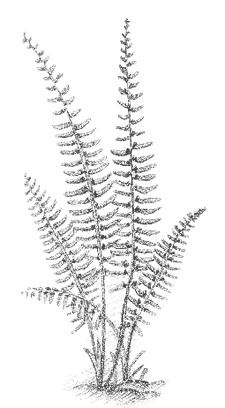 Wildlife
is plentiful, and it is common to observe deer, raccoons, opossums, armadillos,
wild hogs, pileated woodpeckers, ibis, vultures, and kingsnakes. Waterfowl is
abundant in the swamps during migratory seasons, as are otters during the entire
year. Alligators are surprisingly absent.
Wildlife
is plentiful, and it is common to observe deer, raccoons, opossums, armadillos,
wild hogs, pileated woodpeckers, ibis, vultures, and kingsnakes. Waterfowl is
abundant in the swamps during migratory seasons, as are otters during the entire
year. Alligators are surprisingly absent.
Three generations of LeContes lived at Woodmanston, along with at least 200 slaves. John Eatton LeConte was the grandson of Guillaume LeConte, a French Huguenot who migrated to New York in the 1690s to avoid religious persecution, and the nephew of Thomas Eatton, a prominent Savannah merchant who may have influenced LeConte to invest in Georgia. John Eatton LeConte had a brother, William, who founded Sans Souci Plantation in Bryan County. Naturalist William Bartram traveled through the property in 1773.
John Eatton LeConte was an early supporter of the American Revolution, and was entrusted with delivering rice and sterling to Boston patriots who were suffering from the British embargo of Boston Harbor. During the Revolutionary War, the original plantation house was burned by British troops in November of 1778 as they advanced on Midway down the Fort Barrington Road. Sometime before 1789, another house was built at the plantation. It was fortified and featured a palisade stockade. In 1789, this "fort" was attacked by Indians and was successfully defended by LeConte and his slaves. LeConte later had two sons, Louis, born 1782, and John Eatton LeConte Jr., born 1784.
Around 1812, Louis married Ann Quarterman of Midway and acquired Woodmanston. Louis, a graduate of Columbia College in New York, planted and nurtured the 1-acre floral and botanical garden of international repute at Woodmanston, and fathered two sons, John and Joseph, who were to go on to international fame as educators and scientists. His family is considered to be Georgia's most distinguished family of scientists. Both sons graduated from Franklin College, which was to become the University of Georgia. John was the first president of the University of California, and received national acclaim for his work in the field of physics. Joseph, an authority on ornithology and geology, achieved the greatest fame of all the LeContes, and published 200 scientific articles and seven books. He graduated from the first graduate course ever offered by Harvard University, studying under famed scientist Louis Agassiz.
Joseph became an expert on coral formation, which he studied with Agassiz in the Florida Keys. With his friend John Muir, Joseph co-founded the Sierra Club. Joseph's greatest expertise might have been as an ornithologist, and with his brother John, he published the first list of all bird species in the state of Georgia, a catalog of 273 species.
Louis LeConte not only ran a productive rice and cotton plantation, but he excelled in growing many unusual native and exotic plants, and was one of the first to cultivate Camellia japonica outdoors in the South. His garden was "the richest in bulbs I have ever seen," wrote Alexander Gordon in Gardener's Magazine. His son Joseph wrote in his Autobiography of Joseph LeConte that his father's "beautiful garden became celebrated all over the United States, and botanists from the North and from Europe came to visit it, always receiving welcome and entertainment, sometimes for weeks at his home." Joseph recalled that some of the camellias were "trees" that were 1 foot in diameter and 15 feet tall.
Louis LeConte's brother, Major John Eatton LeConte Jr., was at one time a co-owner of Woodmanston and considered the foremost authority on the natural history of Georgia at that time. John Eatton also was an accomplished artist—called "the Audubon of the turtles"—and collected many specimens of plants and animals that reside in the natural history collections of the Academy of Natural Sciences of Philadelphia. He was well known for his studies of American insects. Some of his paintings are in the collection of the University of Georgia. His son, John Lawrence LeConte, became a leading entomologist of the latter half of the nineteenth century. Two bird species are named for him: the LeConte thrasher (Toxostoma lecontei), and the LeConte sparrow (Ammospiza leconteii). The LeConte sparrow winters in southeastern Georgia and was named for John Lawrence LeConte by John James Audubon. Not only do two birds carry the LeConte name, but so do two mountains (one in the Smokies and the other in the Sierras); many other landmarks in the Sierras including a lake, a falls, a divide, and a dome; a glacier in Alaska; three species of plants; three fossils; a pear tree (Pyrus lecontei); a mouse; a school; three university buildings; and three avenues (located in Athens, Atlanta, and Berkeley, California).
After Louis LeConte's death in 1838, the estate was divided into smaller tracts for his heirs and the gardens were soon neglected. After 1843, no member of the family resided in the old plantation house. During the Civil War, the plantation was raided and destroyed. Over time, the property was neglected, was farmed and logged, and became a pine plantation and reclaimed bottomland, and the plantation was lost.
Hard work and initiative rediscovered Woodmanston. An avid amateur horticulturist, Col. Claude A. Black, who learned about the plantation in 1971, began a dedicated search for the garden site. Finally, in 1973, he and a friend, William Fishback, found traces of the old garden: two sabal palm trees (one live, one dead), an ancient red seedling (Norman Red) camellia plant, and a few crape myrtles. Brunswick Pulp and Paper Company planned to log the site, but Black convinced the company to hold off. An organization was quickly formed to preserve the site, and it was placed on the National Register of Historic Sites. In 1977, the C.B. Jones family donated the tract to The Nature Conservancy and Brunswick Pulp and Paper donated the timber rights. The title was transferred to the Garden Club of Georgia, which transferred it to the LeConte-Woodmanston Foundation in 1993. The Foundation continues fundraising activities and restoration work at the historic property, and plans to build a visitors center.
[Fig. 14(4)] Melon Bluff Nature and Heritage Preserve is one of the few privately owned nature preserves on the Georgia coast. The 3,000-acre preserve backs up to the North Newport River and offers more than 20 miles of trails through pinelands, coastal forest, and salt marshes that are open to hikers, bikers, kayakers, and horseback riders. History is also highlighted at Melon Bluff, with a former rice plantation on the property and a Civil War blockade-runner, The Standard, sunk at the bottom of the tidal river.
The preserve is a charter member of the Colonial Coast Birding Trail established by the Georgia Department of Natural Resources. Surrounded by coastal marsh, moss-draped oaks and pines, and freshwater ponds, it serves as sanctuary to resident and migratory bird species, including osprey, herons, egrets, wood storks, pelicans, spoonbills, wild turkeys, bluebirds, swallows, painted buntings, and purple martins. Bald eagles are occasionally identified. Commonly seen in the dense, mixed hardwood and pine forest are deer, opossums, raccoons, and squirrels.
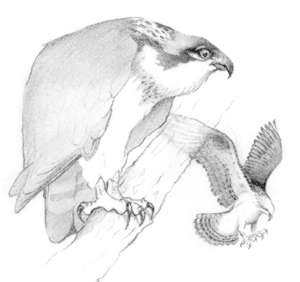 Like
most coastal property, Melon Bluff has not escaped human intervention. It has
experienced timber operations and rice production. The preserve is named for
the eighteenth century plantation that once existed on the property. More recently,
the property had been managed for pine timber like much of coastal Georgia.
Conservationists Laura, Don, and Meredith Devendorf have chosen to protect and
allow the landscape to renew itself through the creation of a nature preserve
from this land that has been in the family since the 1930s. The family was also
instrumental in establishing Seabrook Village (see Seabrook
Village).
Like
most coastal property, Melon Bluff has not escaped human intervention. It has
experienced timber operations and rice production. The preserve is named for
the eighteenth century plantation that once existed on the property. More recently,
the property had been managed for pine timber like much of coastal Georgia.
Conservationists Laura, Don, and Meredith Devendorf have chosen to protect and
allow the landscape to renew itself through the creation of a nature preserve
from this land that has been in the family since the 1930s. The family was also
instrumental in establishing Seabrook Village (see Seabrook
Village).
An unusual feature of Melon Bluff is that it offers three historic B&B-style lodging options, Palmyra Barn (1930), Palmyra Plantation Guest House (1840), and The Ripley Farmhouse (1940). The three restored structures offer beautiful views of Dickinson Creek or the peacefulness of the coastal woodlands.
The Devendorfs keep a busy schedule of events year-round to interest visitors. The preserve participates in the national annual Audubon bird count and commemorates the anniversary of Prohibition with moonshine-making demonstrations and a kayak trip to an island where rum was stashed in the Roaring Twenties. Flatwater kayaking in the tidal rivers is featured, including sunrise excursions followed by a gourmet breakfast, heritage kayak tours, picnic paddles to a marsh island, and moonrise excursions followed by candlelit dinners. Another popular activity is a mule-drawn wagon tour of the preserve, where a guide describes the history of the area from Spanish times to plantation days.
The Melon Bluff Nature Center is where guests start their visit. Educational exhibits, a gift shop-bookstore, refreshments, and restrooms are available. Self-guiding nature and heritage tours are available. Bikes and binoculars can be rented, and on the weekend canoes and kayaks are supplied. Mule and wagon tours are scheduled at certain events or by special arrangement.
[Fig. 14(5)] This living history village features the rich African-American culture that developed when slaves were freed from coastal plantations. The focus is on the authentic portrayal of the struggles and successes of African-Americans from 1865 to 1930, with interactive demonstrations and programs on history, folklore, folklife, architecture, crafts, and found art. Here you can experience what it was like before modern conveniences by trying your hand at washing clothes on a scrub board or grinding corn into meal and grits. Exhibits display ingenious artifacts of the period, such as a peanut roaster made from sewing machine and bicycle parts, a photograph framed with matchsticks, twig furniture, and other items. Ongoing exhibits include the grave art of Cyrus Bowens, featured in Drums and Shadows. The 104-acre site has eight buildings built in the 1900s, including the one-room Seabrook School and various farm buildings.
A biracial local community group created Seabrook in 1990. One of the founders is Laura Devendorf, who also created the private nature preserve of Melon Bluff (see Melon Bluff). The best way to visit is by prearranging a group tour. Seabrook arranges for costumed interpreters who come from community families whose roots go back over 150 years. The tour lasts three hours, and full meal service, picnics, and entertainment are available. Special events include Old Timey Days, Country Christmas, storytelling, cane grinding, syrup making, rice planting, and clay chimney building. The site is open to self-guided walking tours as well.
[Fig. 14(6)] Despite the sad fact that not one structure survives from the colonial town of Sunbury, once a busy seaport on the Medway River, there are nearby attractions that can invoke the ghosts of this early Georgia settlement. History buffs can enjoy the beauty of the Georgia coast while touring the remains of a fort that protected the town during the Revolutionary War and War of 1812. Nearby, a historic cemetery contains the graves of some of Sunbury's prominent citizens. Fort Morris's natural charms are recognized by its selection as a site on the Colonial Coast Birding Trail established by the Georgia Department of Natural Resources.
The walking tour of the fort is a great way to learn Georgia's role in the Revolutionary War while enjoying beautiful views of golden marsh and shimmering tidal river. From the bluff, one can look out on St. Catherines Sound and to barrier islands in the distance. Magnolia, live oak, southern red oak, water oak, sweetgum, cabbage palm, and slash pine grow on the 70 acres, providing sanctuary for many species of birds. Wax myrtle, yaupon holly, and assorted ferns thrive in the understory. The productive Spartina marshes absorb the tides, supporting many wading birds that can be seen year round, including snowy egrets, great blue and little green herons, wood storks, and anhingas. Yellow-crowned night herons nest here and are observed in spring and early summer. Bald eagles, Cooper's hawks, and red-tailed hawks are frequently seen in the fall and winter. Thriving in the woods are deer, raccoons, opossums, armadillos, and squirrels. Occasionally, snakes are spotted sunning themselves on the sandy banks.
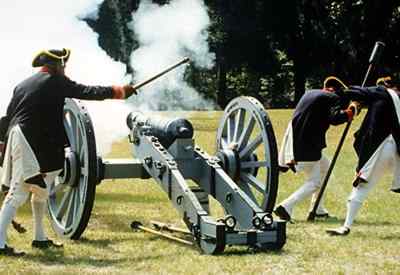 The
trees around the fort are second growth. The land was completely cutover when
the fort was built, and the timber was used in building the fort and also to
clear a field of fire. The fort you tour is actually the third or fourth built
near this location. The earthworks seen today date back to at least the War
of 1812, reshaped from the Revolutionary War fort, Fort Morris.
The
trees around the fort are second growth. The land was completely cutover when
the fort was built, and the timber was used in building the fort and also to
clear a field of fire. The fort you tour is actually the third or fourth built
near this location. The earthworks seen today date back to at least the War
of 1812, reshaped from the Revolutionary War fort, Fort Morris.
As the plantations of Midway and St. Johns Parish flourished, locals decided they needed a more convenient port than Savannah for shipping their exports of rice, indigo, skins, lumber, tar, and rosin. In 1758, Mark Carr chose 500 acres on a low bluff on the southern bank of the Medway River for a new settlement and port of entry called Sunbury. The river, with depths ranging up to more than 40 feet, provided safe passage and docking for large ships. (The Medway is believed to be one of the deepest natural rivers south of the Chesapeake.) The road from Midway to Sunbury followed one of the oldest Indian trails in the state, which linked Georgia's mountains to its coast with its southern terminus at Sunbury.
Town planners ambitiously laid out the village in a grid with 496 lots and three public squares—Kings, Church, and Meeting—and five wharves. It was named Sunbury, either for the English town on the Thames River or for its sunny location on the Medway River. The town prospered, and was said to rival Savannah in commercial importance, with Sunbury residents owning a third of all the wealth in Georgia by 1772. Records show that in 1773, Sunbury's port hosted 56 vessels compared with Savannah's 160 ships. At one point Sunbury consisted of 80 homes, a customs house, several businesses, and a naval office. Eighteenth century naturalist William Bartram visited the town several times during his travels in the 1760s, and described it as a town of two-story houses "with pleasant piazzas around them where the genteel, wealthy planters resorted to partake of the sea breeze, bathing, and sporting on the Sea Islands."
Forts protected Georgia's frontier towns from Spanish and Indian attacks, and Sunbury was no different. In 1755, a small battery was built just south of Sunbury on the first piece of high ground overlooking the Medway River. By 1760, a log fort had been added to protect Sunbury residents from Indian attacks. As the American Revolution approached, a new fort was constructed in 1776 to protect the town from British invasion. Constructed of earth and wood by slaves, this eventually was christened Fort Morris, named for Captain Thomas Morris, who commanded the company of artillery that first garrisoned the fort. The fort mounted 24 guns and housed 250 officers and men. A large, brick officers' barracks stood in the center.
In the fall of 1778, the British launched a two-prong invasion of Georgia. A land force under Lt. Col. Mark Prevost was to march from Fort Howe (Fort Barrington) on the Altamaha River to the Midway Meeting House, then turn and march east to Sunbury. A naval force under Lt. Col. L.V. Fuser was to attack Sunbury from the river, while the land force attacked from land. After the fall of Sunbury, they were to proceed to Savannah.
Several skirmishes were fought as the Americans attempted to delay or prevent Prevost from capturing Midway. Commanding the American patriots was Colonel John White. As he continued to fight Prevost, he sent Colonel John McIntosh and 127 men to reinforce Sunbury. When White realized he couldn't hold Midway, he abandoned the town and allowed a letter to fall into British hands that was intended to deceive them into thinking the Americans had reinforcements on the way. Prevost, who had learned that Fuser was delayed in his approach on Sunbury from the river, decided to burn Midway and retreat, burning and plundering on the way back to the British colony of East Florida.
Fuser, with a naval force of approximately 500 men, arrived at Sunbury in late November 1778 and put the fort and town under siege. He sent a message to the fort demanding its surrender. Colonel McIntosh, the ranking officer, answered the letter with the famous reply, "Come and take it." Fuser, learning that Prevost had retreated and unsure of the strength of the American troops at Fort Morris, decided to retreat as well. In December, a force of 3,000 British troops captured Savannah, thereby isolating Sunbury and Fort Morris. Again the British approached Sunbury and demanded Fort Morris to surrender. The fort's new commander, Major Joseph Lane, was under orders from his superiors to evacuate. But Lane decided to stay and fight. In the ensuing battle on January 9, 1779, the fort was lost to the British, with four Americans killed and seven wounded. The winners renamed the bastion Fort George in honor of King George III, and Sunbury became a military prison for patriot officers. Lane was later court-martialed for disobeying orders.
By the end of the war, the fort was dismantled and most of the town lay in ruins. In 1782, the British evacuated Georgia, and Sunbury attempted to rebuild. It was named county seat for the new county called Liberty, but never fully regained its prewar prominence. In 1793, Sunbury Academy was established. It became one of the finest schools in the South under the 30-year leadership of the Irish-born Rev. Dr. William McWhir, an outstanding Greek and Latin scholar who was a friend of George Washington. Located in King's Square, Sunbury Academy's students went on to become leaders in many fields.
At the turn of the century, much of Liberty County had recovered, but Sunbury was losing its importance as a seaport. New bridges and roads allowed easier access to Darien and Savannah ports, and Sunbury's population dwindled and the county seat was moved to Riceboro. The area was briefly revitalized in 1812 when Fort Morris was reconfigured into the smaller Fort Defiance that tourists see today. A body of students manned the fort in order to protect Liberty County from British invasion during the War of 1812 but no military assaults ever came. More destructive, however, were tremendous hurricanes and yellow fever epidemics that all but obliterated the town. During the Civil War, Union cavalry pillaged the county and burned a historic church in Sunbury as a signal to the Union Navy in St. Catherines Sound. After the Civil War, the few remaining buildings of any value were moved to Dorchester. The only building in the area still standing from the mid-1800s is Dorchester Presbyterian Church, built in 1854. The church's bell is originally from Sunbury. (Directions to Dorchester Presbyterian Church: From I-95, drive 2.2 miles to Dorchester historical marker on right. Turn right on dirt road and drive 0.2 mile to church on left.) The property was abandoned and left to relic hunters and the forces of nature for 100 years until the Georgia Historical Commission purchased the site in 1968. The site was placed on the National Register of Historic Places in 1971, and in 1973, The Nature Conservancy helped the state acquire 3 more acres that contain the old earthworks.
Sunbury Cemetery is the only physical remains of the once thriving seaport. The cemetery is believed to have occupied the southeast corner of Church Square. Only 34 markers remain, with the earliest dated 1788 and the latest marked 1911. The most famous marker belongs to the Rev. Dr. William McWhir, the famous principal of Sunbury Academy, who died in 1851 at the age of 91.
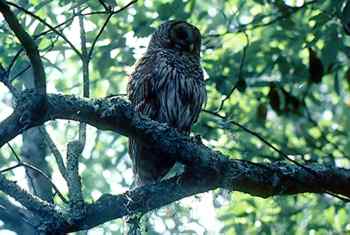 Youman's
Pond and Colonel's Island
Youman's
Pond and Colonel's Island [Fig. 14(7)] This freshwater pond found on Colonel's Island is an excellent bird-watching site. It has supported an active rookery for many years, and many bird species have been identified here, including black-crowned and yellow-crowned night herons, blue herons, various egrets, wood storks, ibis, wood ducks, and common moorhens. Dabbling ducks are common during migratory seasons. Great horned and barred owls, osprey, and turkey vultures are frequently seen in the area.
The island is the easternmost piece of high ground in Liberty County before crossing the Newport rivers to St. Catherines Island. The southern half of the island is also known as Halfmoon Landing, named for the bend in the tidal river located here. Many bird species depend on a mix of habitats. They feed in the marsh and freshwater wetlands, then take refuge in nearby undisturbed maritime forest. Colonel's Island has a variety of natural habitats that support a diversity of avifauna.
In April 1773, the island was visited by famed naturalist William Bartram, who described the area in his famous book Travels of William Bartram. Bartram recorded "a great variety of trees, shrubs and herbaceous plants." He wrote that deer "… are numerous on this island; the tyger, wolf, and bear, hold yet some possession; as also raccoons, foxes, hares, squirrels, rats, and mice, but I think no moles … opossums are here in abundance, as also pole-cats, wild-cats, rattle-snakes, glass-snake, coach-whip-snake, and a variety of other serpents." Deer are still common in the area, but tygers (panthers), wolves, and bears are long gone from Colonel's Island. One hopes the wildlife still living on Colonel's Island that depends on the sanctuary of Youman's Pond will not be driven away by further development.
Read and add comments about this page